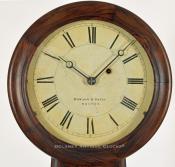Howard & Davis Model No. 3 wall clock. Boston, Massachusetts. ZZ-26.
This Model No. 3 wall timepiece or banjo clock is nicely proportioned, measuring 3 feet 2 inches long. The case is constructed in cherry and retains its faux graining. The graining is added on Howard & Davis banjo clocks. India ink is said to have been applied with a feather at the factory. This decorative treatment is concentrated on the frames and provides the cherry case the appearance of being built in rosewood. The finish is quite good and is original to this example. The zinc dial measures 9 inches in diameter. The dial is signed by the Makers in the appropriate location. Behind this dial, the case is fitted with a weight-driven movement. This is mounted to the case with a single screw. The heavy plates are rectangular shaped. The weight is cast iron. The pendulum rod is made of seasoned cherry and retains its original black paint. The bob is zinc covered in brass. This swings in front of a wooden weight board. Both painted tablets are original to this clock and are in very good original condition. This clock was made circa 1850.
The Howard & Davis firm was formed in Boston, Massachusetts, by Edward Howard and David Porter Davis in 1842. Both men were trained and served their apprenticeship in clockmaking to Aaron Willard Jr. of Roxbury, Massachusetts. Their partnership lasted approximately ten years. From 1844 through 1847, Luther S. Stephenson joined the partnership, which was then called Stephenson, Howard & Davis. It is now currently thought that the Howard & Davis name was only used after Stephenson departed. The Howard & Davis Clock Company was located at No 34 Water Street. Here they built a reputation for building very high-quality items, which included various forms of high-grade clocks and precision balances or scales. Banks used gold standard balances. Letter balances were built under contract for the United States Government. These were used in state and county offices. Town standards (scales) and Druggist's balances were also manufactured along with the necessary weights. The company also made sewing machines and fire pumpers. In 1857, the Howard & Davis firm was dissolved when D. P. Davis left to pursue other ventures. In 1857, Davis was part of Davis, Polsey & Co. This firm identified itself as the "late Howard and Davis." They manufactured clocks and a line of pull cord, pin registration watch clocks. This firm lasted until 1860. Posley continued to make these clocks on his own. In 1858, E. Howard began to sign his clocks, E. Howard & Co. This firm enjoyed many prosperous years making clocks and later watches until he retired in 1881.










